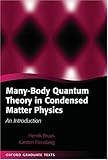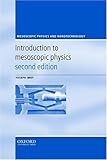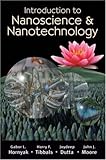|
|
Help |
| Home - Basic N - Nanotechnology Physics (Books) | |
e99 Online Shopping Mall
|
|
Help |
| Home - Basic N - Nanotechnology Physics (Books) | |
| 1-20 of 100 | Next 20 |
click price to see details click image to enlarge click link to go to the store
| 1. Nanophysics and Nanotechnology: An Introduction to Modern Concepts in Nanoscience (Physics Textbook) by Edward L. Wolf | |
 | Paperback: 308
Pages
(2006-10-23)
list price: US$85.00 -- used & new: US$66.22 (price subject to change: see help) Asin: 3527406514 Average Customer Review: Canada | United Kingdom | Germany | France | Japan |
|
Editorial Review Product Description Customer Reviews (2)
| |
| 2. Quantum Wells, Wires and Dots: Theoretical and Computational Physics of Semiconductor Nanostructures by Paul Harrison | |
 | Paperback: 564
Pages
(2010-02-16)
list price: US$69.95 -- used & new: US$54.53 (price subject to change: see help) Asin: 047077097X Average Customer Review: Canada | United Kingdom | Germany | France | Japan |
|
Editorial Review Product Description Customer Reviews (2)
| |
| 3. Many-Body Quantum Theory in Condensed Matter Physics: An Introduction (Oxford Graduate Texts) by Henrik Bruus, Karsten Flensberg | |
 | Hardcover: 466
Pages
(2004-11-11)
list price: US$109.99 -- used & new: US$74.60 (price subject to change: see help) Asin: 0198566336 Average Customer Review: Canada | United Kingdom | Germany | France | Japan |
|
Editorial Review Product Description Customer Reviews (2)
| |
| 4. Nanotechnology (AIP-Press) | |
 | Hardcover: 696
Pages
(1998-12-21)
list price: US$199.00 -- used & new: US$120.62 (price subject to change: see help) Asin: 0387983341 Average Customer Review: Canada | United Kingdom | Germany | France | Japan |
|
Editorial Review Product Description Customer Reviews (1)
| |
| 5. Introduction to Mesoscopic Physics (Mesoscopic Physics and Nanotechnology) by Yoseph Imry | |
 | Paperback: 252
Pages
(2008-12-15)
list price: US$60.00 -- used & new: US$40.00 (price subject to change: see help) Asin: 019955269X Average Customer Review: Canada | United Kingdom | Germany | France | Japan |
|
Editorial Review Product Description Customer Reviews (3)
| |
| 6. Nano : The Emerging Science of Nanotechnology by Ed Regis | |
 | Paperback: 336
Pages
(1996-04-01)
list price: US$19.99 -- used & new: US$9.12 (price subject to change: see help) Asin: 0316738522 Average Customer Review: Canada | United Kingdom | Germany | France | Japan |
|
Editorial Review Product Description Customer Reviews (22)
| |
| 7. Nanotechnology-Enabled Sensors by Kouroush Kalantar-zadeh, Benjamin Fry | |
 | Paperback: 492
Pages
(2010-11-02)
list price: US$149.00 -- used & new: US$103.55 (price subject to change: see help) Asin: 1441940855 Canada | United Kingdom | Germany | France | Japan |
|
Editorial Review Product Description Nanotechnology provides tools for creating functional materials, devices, and systems by controlling materials at the atomic and molecular scales and making use of novel properties and phenomena. Nanotechnology-enabled sensors find applications in several fields such as health and safety, medicine, process control and diagnostics. This book provides the reader with information on how nanotechnology enabled sensors are currently being used and how they will be used in the future in such diverse fields as communications, building and facilities, medicine, safety, and security, including both homeland defense and military operations. | |
| 8. Quantum Chaos and Quantum Dots (Mesoscopic Physics and Nanotechnology) by Katsuhiro Nakamura, Takahisa Harayama | |
 | Hardcover: 216
Pages
(2004-02-12)
list price: US$149.99 -- used & new: US$40.98 (price subject to change: see help) Asin: 0198525893 Canada | United Kingdom | Germany | France | Japan |
|
Editorial Review Product Description | |
| 9. Nanotechnology: Basic Science and Emerging Technologies by Mick Wilson, Kamali Kannangara, Geoff Smith, Michelle Simmons, Burkhard Raguse | |
 | Paperback: 290
Pages
(2002-06-27)
list price: US$77.95 -- used & new: US$44.00 (price subject to change: see help) Asin: 1584883391 Average Customer Review: Canada | United Kingdom | Germany | France | Japan |
|
Editorial Review Product Description Customer Reviews (1)
| |
| 10. Nanoscale Physics for Materials Science by Takaaki Tsurumi, Hiroyuki Hirayama, Martin Vacha, Tomoyasu Taniyama | |
 | Hardcover: 287
Pages
(2009-12-10)
list price: US$89.95 -- used & new: US$71.96 (price subject to change: see help) Asin: 1439800596 Canada | United Kingdom | Germany | France | Japan |
|
Editorial Review Product Description Although there are many books available on the preparation, properties, and characterization of nanomaterials, few provide an interdisciplinary account of the physical phenomena that govern the novel properties of nanomaterials. Addressing this shortfall, Nanoscale Physics for Materials Science covers fundamental cross-disciplinary concepts in materials science and engineering. It presents a comprehensive description of the physical phenomena and changes that can be expected when macroscopically sized materials are reduced to the nanometer level. The text is divided according to physical phenomena and interactions. After reviewing the necessary theoretical background, the authors address the electrical, optical, and magnetic properties as functions of size and distance. They discuss the energy spectrum, the charging effect, tunneling phenomena, electronically induced stable nanostructures, absorption and scattering, electromagnetic interactions, magnetism, ferromagnetic domain-wall-related phenomena, and spin transport in magnetic nanostructures. Problem sets are included at the end of each chapter. Providing an excellent treatment of physical phenomena not covered in similar books, this text explores the electrical, optical, and magnetic properties of materials at the nanoscale level. It delves into the dramatic physical changes that occur on scales where the quantum nature of objects starts dominating their properties. | |
| 11. Introduction to Nanoscience and Nanotechnology by Gabor L. Hornyak, H.F. Tibbals, Joydeep Dutta, John J. Moore | |
 | Hardcover: 1574
Pages
(2008-12-22)
list price: US$141.95 -- used & new: US$113.56 (price subject to change: see help) Asin: 1420047795 Average Customer Review: Canada | United Kingdom | Germany | France | Japan |
|
Editorial Review Product Description The maturation of nanotechnology has revealed it to be a unique and distinct discipline rather than a specialization within a larger field. Its textbook cannot afford to be a chemistry, physics, or engineering text focused on nano. It must be an integrated, multidisciplinary, and specifically nano textbook. The archetype of the modern nano textbook, Introduction to Nanoscience and Nanotechnology builds a solid background in characterization and fabrication methods while integrating the physics, chemistry, and biology facets. The remainder of this color text focuses on applications, examining engineering aspects as well as nanomaterials and industry-specific applications in such areas as energy, electronics, and biotechnology. Also available in two course specific volumes Introduction to Nanoscience elucidates the nanoscale along with the societal impacts of nanoscience, then presents an overview of characterization and fabrication methods. The authors systematically discuss the chemistry, physics, and biology aspects of nanoscience, providing a complete picture of the challenges, opportunities, and inspirations posed by each facet before giving a brief glimpse at nanoscience in action: nanotechnology. Fundamentals of Nanotechnology surveys the field’s broad landscape, exploring the physical basics such as nanorheology, nanofluidics, and nanomechanics as well as industrial concerns such as manufacturing, reliability, and safety. The authors then explore the vast range of nanomaterials and systematically outline devices and applications in various industrial sectors. All three volumes provide, upon qualifying course adoption, online access to a wealth of instructional materials including detailed lecture notes, review summaries, slides, exercises, solutions, and more. The authors provide enough material for both one and two semester courses. Customer Reviews (1)
| |
| 12. Nanotechnology: Understanding Small Systems by Ben Rogers, Sumita Pennathur, Jesse Adams | |
 | Hardcover: 416
Pages
(2007-11-29)
list price: US$95.95 -- used & new: US$75.00 (price subject to change: see help) Asin: 0849382076 Canada | United Kingdom | Germany | France | Japan |
|
Editorial Review Product Description Working from the ground up, this text provides a detailed yet accessible introduction to the world’s fastest growing field. Through real-world examples, hundreds of homework problems, original illustrations, and a clear approach, the authors accomplish the delicate task of keeping the book engaging while not avoiding real explanations of complex concepts. They take a systems-based approach, demonstrating how an understanding of the various areas underlying nanotechnology come together to create systems with unique functions and characteristics. In every case, comparing nanoscale systems to macroscale systems reveals the complex and fundamental differences between phenomena at different scales and uncovers the specific challenges posed by nanotechnology. With comprehensive coverage conveyed in an engaging and entertaining style, Nanotechnology: Understanding Small Systems provides a gateway into the exciting and rapidly evolving area of nanotechnology. | |
| 13. Quantum Nanoelectronics: An Introduction to Electronic Nanotechnology and Quantum Computing by Edward L. Wolf | |
 | Paperback: 472
Pages
(2009-05-19)
list price: US$75.00 -- used & new: US$58.39 (price subject to change: see help) Asin: 3527407499 Canada | United Kingdom | Germany | France | Japan |
|
Editorial Review Product Description Cover graphics: Arindam Bandyopadhyay | |
| 14. Molecular Building Blocks for Nanotechnology: From Diamondoids to Nanoscale Materials and Applications (Topics in Applied Physics) (No. 111) | |
 | Hardcover: 428
Pages
(2007-04-20)
list price: US$215.00 -- used & new: US$149.84 (price subject to change: see help) Asin: 0387399372 Canada | United Kingdom | Germany | France | Japan |
|
Editorial Review Product Description This book deals with a "bottom-up" approach to building nanostructured systems, where one starts with atoms and molecules, which constitute the molecular building blocks (MBBs), and assembles them to build a nanostructured material. Nanotechnology MBBs are distinguished for their unique properties. They include, for example, graphite, fullerene, carbon nanotubes, diamondoids, nanowires, nanocrystals and amino acids. All these MBBs, and more, are candidates for various applications in nanotechnology. These building blocks have quite unique properties not found in small molecules. Some of these MBBs are electrical conductors, some are semiconductors, some are photonic, and the characteristic dimension of each is a few nanometers. The examples covered in this book by the sixteen chapters written by authorities all around the world include: (1) carbon nanotubes, which are five times lighter and five times stronger than steel; (2) nanowires, which can be made of metals, semiconductors, or even different types of semiconductors within a single wire; and (3) diamondoids, a form of pure carbon materials which provide excellent building blocks for positional (or robotic) assembly as well as for self-assembly. The applications of MBBs as presented in this book should enable the practitioner of nanotechnology to design and build systems on a nanometer scale. The controlled synthesis of MBBs and their subsequent assembly (self-assembly, self-replication or positional-assembly) into nanostructures is a fundamental theme of nanotechnology. These promising nanotechnology concepts with far-reaching implications (from mechanical to chemical processes; from electronic components to ultra-sensitive sensors; from medical applications to energy systems; and from pharmaceuticals to agricultural and food chains) will impact every aspect of our future. | |
| 15. Introduction to Scanning Tunneling Microscopy (Monographs on the Physics and Chemistry of Materials) by C. Julian Chen | |
 | Hardcover: 432
Pages
(2007-12-05)
list price: US$150.00 -- used & new: US$115.99 (price subject to change: see help) Asin: 0199211507 Average Customer Review: Canada | United Kingdom | Germany | France | Japan |
|
Editorial Review Product Description Customer Reviews (1)
| |
| 16. Nanocomputing: Computational Physics for Nanoscience and Nanotechnology by James Hsu | |
 | Hardcover: 384
Pages
(2009-03-01)
list price: US$135.00 -- used & new: US$86.94 (price subject to change: see help) Asin: 9814241261 Canada | United Kingdom | Germany | France | Japan |
|
Editorial Review Product Description | |
| 17. Nanotechnology and its Applications: First Sharjah International Conference on Nanotechnology and Its Applications (AIP Conference Proceedings / Materials Physics and Applications) | |
| Hardcover: 272
Pages
(2007-09-05)
list price: US$115.00 -- used & new: US$115.00 (price subject to change: see help) Asin: 0735404399 Canada | United Kingdom | Germany | France | Japan | |
|
Editorial Review Product Description All papers have been peer-reviewed. The scope of this conference was to cover nanotechnology and its applications in the following areas: 1. Environmental applications: sensors of pollutants, pollution remediation and green nanotechnology. 2. Petrochemical applications: petroleum refinement and production of gasoline from methanol. 3. Material properties and basic science aspects of nanotechnology such as synthesis, characterization, assembly and processing of nanostructures. 4. Theory, modeling and simulation. Among the topics discussed were nanoscience and nanotechnology including synthesis and characterization of nanomaterials, environmental applications, computational, theory, and simulation of nanostructures. | |
| 18. Advanced Materials and Nanotechnology: Proceedings of the International Conference (AMN-4) (AIP Conference Proceedings / Materials Physics and Applications) | |
 | Paperback: 206
Pages
(2009-07-20)
list price: US$139.00 -- used & new: US$28.87 (price subject to change: see help) Asin: 073540688X Canada | United Kingdom | Germany | France | Japan |
|
Editorial Review Product Description The purpose of the conference was to promote international collaborations in the broad areas of advanced materials and nanotechnology, with a particular emphasis on new and emerging technologies. New research was presented by scientists from around the world, providing an up to date snapshot of progress in these fields. | |
| 19. Fullerene C60: History, Physics, Nanobiology, Nanotechnology by Djuro Koruga, Stuart Hameroff, James Withers | |
| Hardcover: 398
Pages
(1993-05)
list price: US$133.50 -- used & new: US$307.52 (price subject to change: see help) Asin: 0444898336 Average Customer Review: Canada | United Kingdom | Germany | France | Japan | |
|
Editorial Review Product Description Customer Reviews (1)
| |
| 20. Quantum Investing: Quantum Physics, Nanotechnology, and the Future of the Stock Market by Stephen R. Waite | |
 | Paperback: 288
Pages
(2004-09-01)
list price: US$20.95 -- used & new: US$14.95 (price subject to change: see help) Asin: 1587991934 Average Customer Review: Canada | United Kingdom | Germany | France | Japan |
|
Editorial Review Product Description Customer Reviews (11)
Despite the above, the authors were clever at choosing the right facts and figures. Some astounding items include:- 1. The only original DJI stock left behind after a century was General Electric. In short, this book is far from what the title projects to say. Little is talked about investment at all. The authors could have written a much better book with much fewer words. To make it better, the authors should have written much more on how complexity theory, a branch in Quantum Physics could really help market and investment analysis.
The process of creative destruction will allow those companies benefiting from yet-to-be-invented technologies to grow at amazing rates, replacing those business that fail to keep pace.Noting that more welath was created during the past 100 years than in all previous history combined, Waite feels the rate of wealth creation will accelerate, with the next 25 years producing more wealth than was created during the entire 20th century. The Industrial Revolution was made possible by technologies generated from Newtonian physics, and our future will be enhanced with inventions from quantum based technologies. ... Read more | |
| 1-20 of 100 | Next 20 |